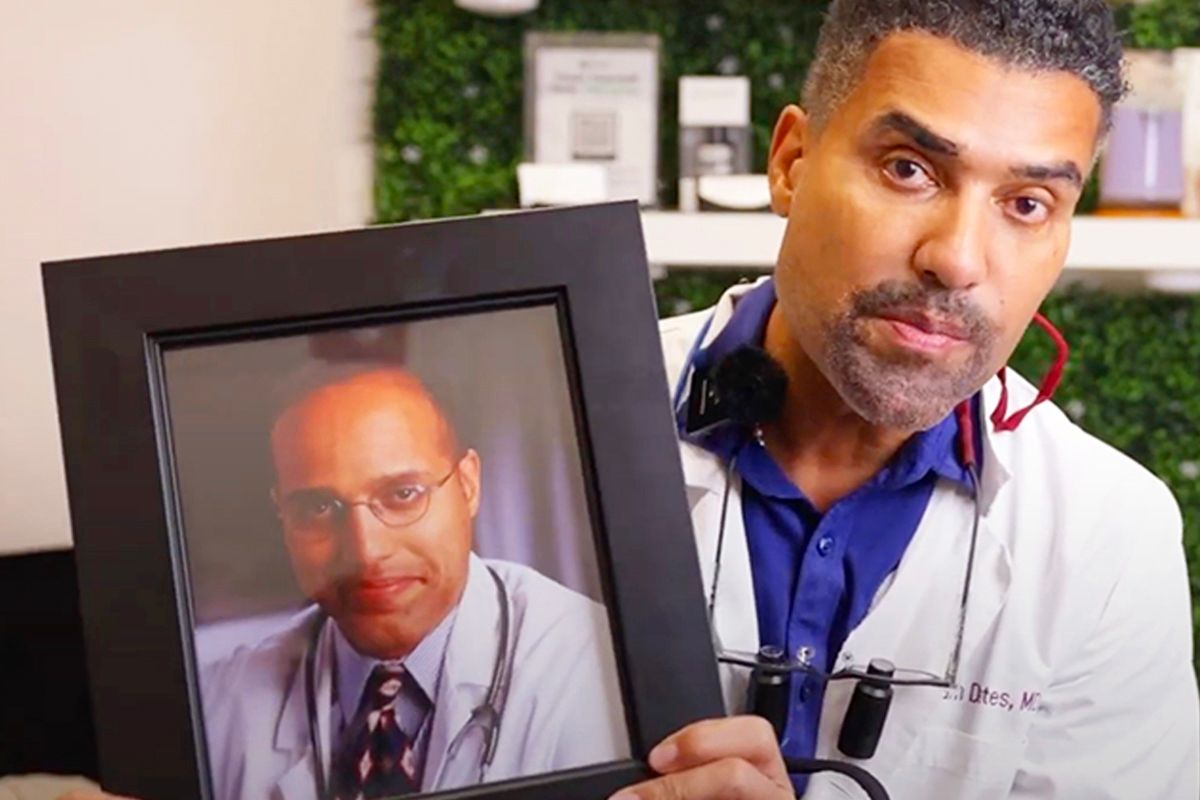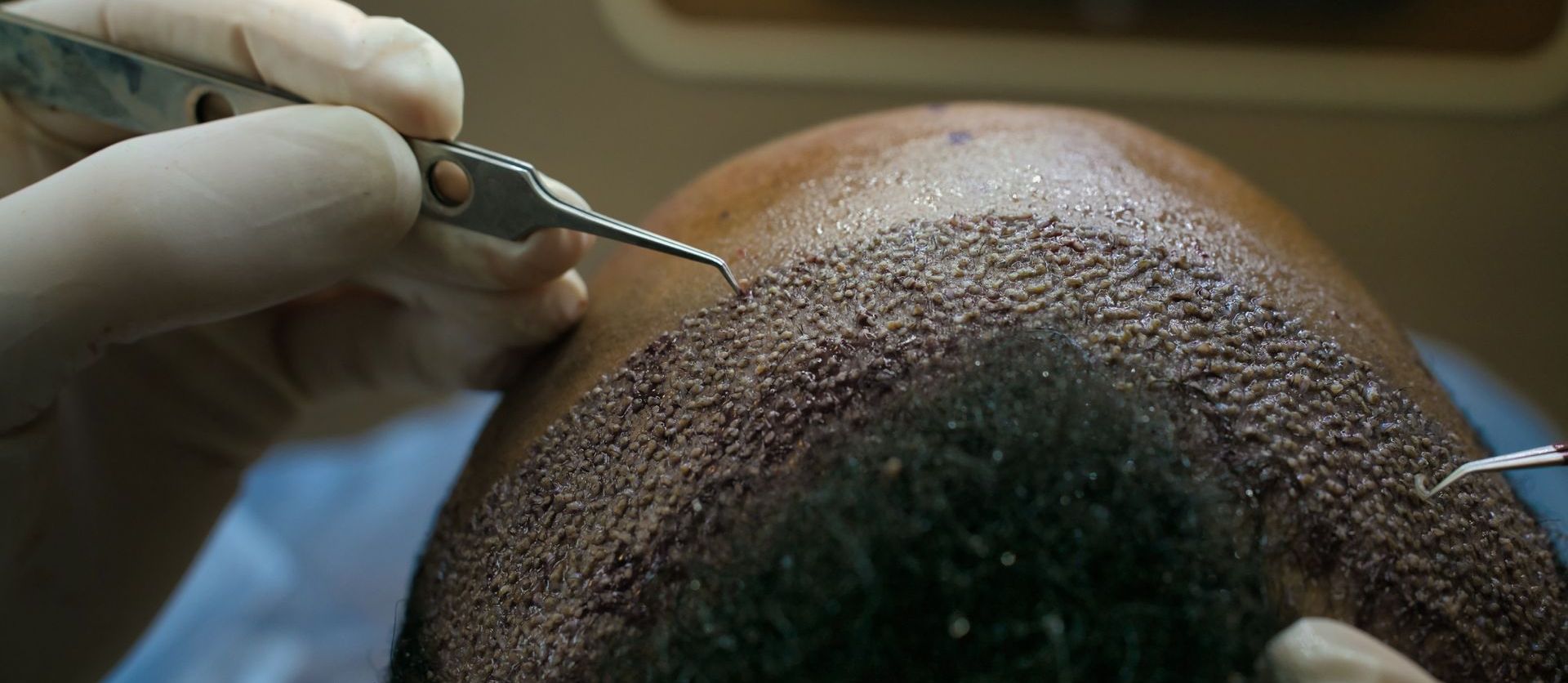



So you’re thinking about getting a hair transplant. Congratulations! A hair transplant is the most effective way to combat thinning hair or hair loss. It’s important to remember, though, that the results come from following your doctor’s instructions, and having patience. Hair transplant results usually take 12 months to show fully (sometimes it can even take a little longer). Remember that these results will be natural-looking, thicker hair, and are worth the wait! This is what to expect at every step of the process.
After your initial
scalp consultation and booking your surgery, your surgeon will harvest healthy hair grafts from areas of your scalp that are still full of hair. The most common method of harvesting hair is
FUE (follicular unit extraction), which leaves you with minimal scarring and maximum new hair growth. FUE is when your surgeon removes individual healthy hair follicles and transplants them to the thin haired areas, with less scarring than older methods.
Immediately after your hair transplant, your head will be tender, so be gentle. In the first few hours after your surgery, you will need to rest and treat the transplanted areas gently. Your doctor may give you specific instructions to follow or a medication to help with swelling, inflammation, or to stave off potential infection.
In the first couple days after your transplant, the swelling and inflammation should start to go away. Follow your doctor’s instructions on washing your hair and caring for your newly transplanted grafts. Basically, don’t rub or pull anything over the grafted area for one week. After about 7 days you will be able to wash your hair with a gentle shampoo and return to your normal hair styling routines. You won’t notice a drastic difference within the first 10 days after your hair transplant, but don’t write off your procedure yet!
Over the next 2-4 weeks after your transplant, your hair grafts that you can see above the skin will fall out. Don't worry: they are just getting out of the way of new hair growth from the hair follicle placed safely under the skin. You won’t start seeing any hair growth for 2-4 months. Every month new hair begins to grow and the hair that started first is starting to get thicker and longer. These new hairs may be growing at different rates or densities––it usually takes a full year for all of the hair to grow out, but amazingly it never looks unnatural during this process. You can style your hair to compliment your changing hair pattern. Wearing hats or scarves are perfectly fine as well.
Between months 6-8 you will see the most new hair growth. This new hair growth may look thin simply because it is new growth. Your hair will start to look its best around 8-12 months after your transplant, if everything goes well and if you follow your doctor’s instructions. After 1 year, you will see your final results. Your hair will likely not change much after that point. Try to keep this in mind if you have a specific event you want your hair to look best for.
Ahead of your appointment, part of your hair will need to be shaved, so your surgeon can harvest healthy grafts from the fullest parts of your hair to implant into the thinning areas. If you do not have enough healthy hair, your doctor may not be able to perform the procedure (e.g. if you are fully bald, or if you have lost your hair due to chemotherapy).
Unfortunately, there is no way to speed up hair growth after your hair transplant. The best way to encourage good results is by following your doctor’s instructions and taking your medication consistently. If you’re worried about your hair not growing after your transplant, give it some time. Waiting for your hair to grow is the hardest part of the procedure! Usually, a celebration visit at your year mark is in order to compare your before and after pictures.
There are some disadvantages to getting a hair transplant: it can be
expensive, there is a minimal recovery time, and it takes a long time to get results, but once you get those results you will be thankful you chose a hair transplant over a different method of hair recovery. There are no other types of hair growth medications that provide the results that a hair transplant can.
Getting a hair transplant is not for everyone. Scalp tissue laxity or stretch (if your scalp tissue lacks enough tension, your hair transplant could fail), density of follicles from where your hair grafts were taken, hair quality, scar tissue on the scalp, and hair curl all affect the way your hair comes back after a hair transplant. These are issues that your surgeon will look for during your consultation ahead of your surgery to check if you are a good candidate.
Transplanted hair is like the rest of the hair on your head: it can still thin or fall out or be damaged by age. You may need
another hair transplant if you see continued hair loss or thinning. A hair transplant is effective, but it doesn’t solve every problem––genetics still play a large role and you may see hair loss in other areas.
After your hair transplant, some individuals desire to do another hair transplant to add additional density or work on an area of the scalp such as the crown that wasn't transplanted initially. Since over 90% of people with thinning hair have genetic hair loss, taking medications such as minoxidil, finasteride or using other therapies such as Laser Light Therapy, PRP (platelet rich plasma) therapy or other treatments, to help stabilize your hair loss and help thicken your existing hair.
The best way to prevent a failed hair transplant is to go to a certified and qualified surgeon, like Dr. Yates. Some hair transplant facilities only have technicians perform the surgeries, rather than an actual surgeon. Try to go to a hair transplant location where a surgeon will be the one performing your surgery. If you feel that your first hair transplant did not take, you can get a second hair transplant. A recent study showed that
68% of hair transplant purchasers achieved their desired results with one hair transplant, while
28% say they received their desired result within 2 hair transplants. Every head is different, so talk to your doctor about what will work best for you.
Getting a hair transplant is not embarrassing–it is empowering. You are combatting hair loss and thinning in the most effective way possible. Your hair transplant will look natural and the new techniques involved in transplants leave less noticeable scars than other techniques, giving you a full head of hair without any noticeable marks. Compared to older methods of hair transplant, Dr. Yates performs the hair transplant to leave you with minimal scarring and hair grafts that will lead to a healthy and full looking head of hair.
Hair transplants are expensive, but remember where better to invest than in your own confidence? There is no other means of hair growth that will get you the results that a hair transplant will. Lots of people might be tempted to go somewhere else for a cheaper surgery, but it’s important to remember that you need your surgeon to be board certified. Cheaper options will lead to cheaper results. At Dr. Yates Hair Sciences, a hair transplant is affordable at $10,000-20,000.
Book your hair thinning or loss consultation with
Dr. Yates Hair Sciences today. Dr. Yates performs each surgery himself, so you can be confident you are getting the best possible care for the best possible results. Our offices are equipped with state-of-the-art technology to make you comfortable and safe. Get started on the path to hair regrowth today!



Ready to love your hair? Call 312.883.9617 for a FREE quote & consultation or fill out the form below
OUR LOCATION
213 N. Stetson Ave
Chicago, IL 60601
HOURS
Copyright ©2025 Dr. Yates Hair Science | All Rights Reserved
Powered by HEAVY LEVITY